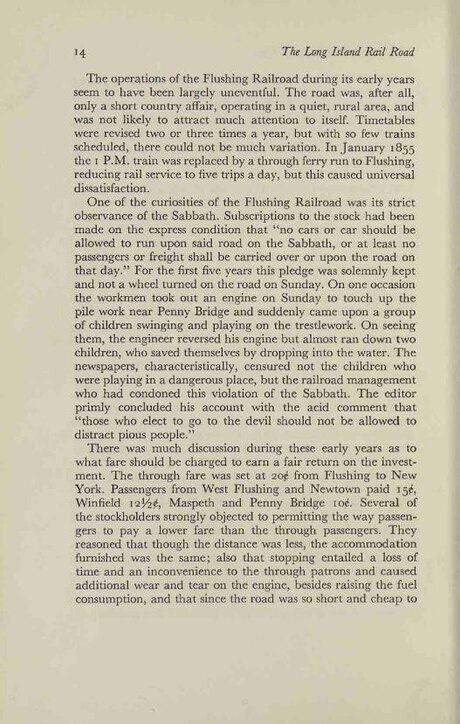The operations of the Flushing Railroad during its early years seem to have been largely uneventful. The road was, after all, only a short country affair, operating in a quiet, rural area, and was not likely to attract much attention to itself. Timetables were revised two or three times a year, but with so few trains scheduled, there could not be much variation. In January 1855 the 1 P.M. train was replacedby a through ferry run to Flushing, reducing rail service to five trips a day, but this caused universal dissatisfaction.
One of the curiosities of the Flushing Railroad was its strict observance of the Sabbath. Subscriptions to the stock had been made on the express condition that "no cars or car should be allowed to run upon said road on the Sabbath, or at least no passengers or freight shall be carried over or upon the road on that day." For the first five years this pledge was solemnly kept and not a wheel turned on the road on Sunday. On one occasion the workmen took out an engine on Sunday to touch up the pile work near Penny Bridge and suddenly came upon a group of children swinging and playing on the trestlework. On seeing them, the engineer reversed his engine but almost ran down two children, who saved themselves by dropping into the water. The newspapers, characteristically, censured not the children who were playing in a dangerous place, but the railroad management who had condoned this violation of the Sabbath. The editor primly concluded his account with the acid comment that "those who elect to go to the devil should not be allowed to distract pious people."
There was much discussion during these early years as to what fare should be charged to earn a fair return on the investment. The through fare was set at 20¢ from Flushing to New York. Passengers from West Flushing and Newtown paid 15¢, Winfield 12½¢, Maspeth and Penny Bridge 10¢. Several of the stockholders strongly objected to permitting the way passengers to pay a lower fare than the through passengers. They reasoned that though the distance was less, the accommodation furnished was the same; also that stopping entailed a loss of time and an inconvenience to the through patrons and caused additional wear and tear on the engine, besides raising the fuel consumption, and that since the road was so short and cheap to
